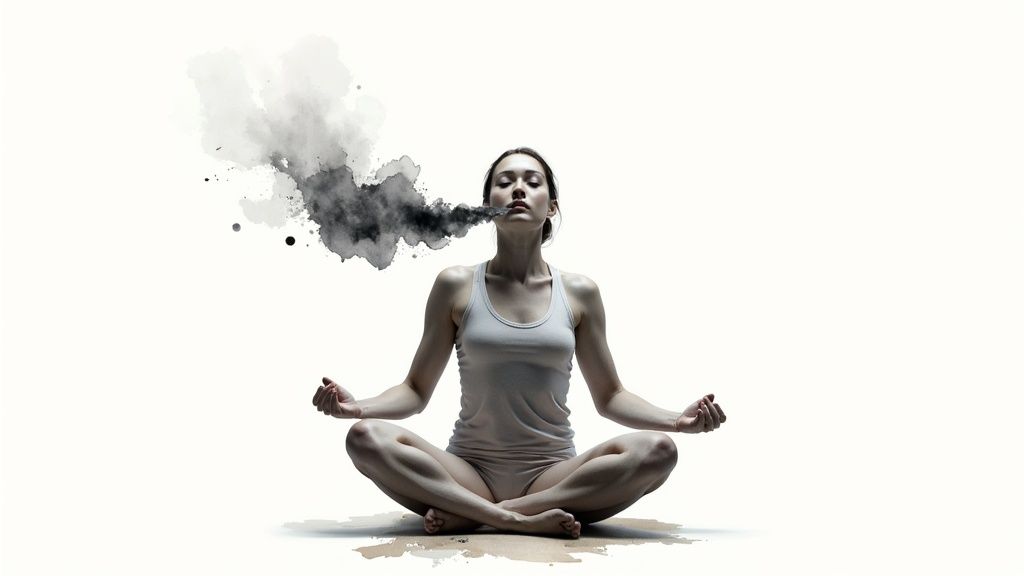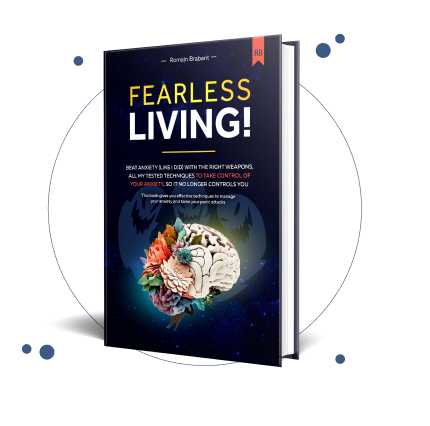
An anxiety attack feels like a sudden, overwhelming wave of intense fear crashing over you without warning. Your heart pounds, your breath shortens, and a sense of impending doom takes over—even when there’s no real danger. It’s a terrifying experience, but it is temporary, and most importantly, it is something you can learn to overcome.
The Sudden Storm: Answering What an Anxiety Attack Feels Like
Imagine a perfectly calm day turning into a violent, terrifying storm in seconds. That’s what an anxiety attack feels like.
It’s more than just feeling nervous; it’s an all-consuming episode where your body's internal fire alarm starts blaring for no apparent reason. This sudden surge of fear can make you feel completely out of control, but that feeling is a temporary illusion.
This experience is both physical and emotional, a full-body response to a perceived threat that isn't actually there. You might be sitting at your desk or walking through a store when suddenly, the floor drops out from under you. Many people describe it as feeling like they are about to die, lose their minds, or have a heart attack.
A Breakdown of the Experience
The sheer intensity of these episodes can be confusing, making you question what is happening to your body.
Anxiety attacks, also known as panic attacks, involve sudden and intense feelings of fear that peak within minutes. On a physical level, this often includes a racing heart, chest pain, trembling, and a sensation of choking—all of which can be truly overwhelming.
This diagram breaks down the core components of an attack, showing how different triggers can lead to a cascade of both physical and mental symptoms.
It helps to see it laid out like this. An attack isn't just one single feeling; it's a complex chain reaction, which explains why it feels so disruptive.
To give you a clearer picture, here’s a quick summary of the different sensations you might experience during an anxiety attack.
Anxiety Attack Sensations At a Glance
| Sensation Type | What It Feels Like |
|---|---|
| Physical | A racing or pounding heart, chest tightness, shortness of breath, trembling, sweating, dizziness, or tingling in your hands and feet. |
| Cognitive | Racing thoughts, a fear of losing control or dying, feeling detached from yourself (depersonalization), or a sense of unreality (derealization). |
| Emotional | An intense surge of fear or dread, feeling overwhelmed and helpless, or an urgent need to escape the situation you're in. |
Seeing these symptoms grouped together can help you recognize what's happening in the moment and remember that these are all classic signs of an anxiety attack—not something more dangerous.
You Are Not Alone, and There Is Hope
Understanding the mechanics of an anxiety attack is the first step toward regaining control. While these moments are frightening, they are not dangerous, and they always pass. Millions of people experience this. You are not alone in this struggle, and many have walked this path to recovery before you.
The most important thing to remember is that you can heal. An anxiety attack does not define you, and it is not a life sentence. With the right tools and understanding, it is entirely possible to navigate through this and live a life free from panic.
This journey begins with knowledge. By learning what an anxiety attack is and how it affects you, you start to strip away its power. For a deeper look into the specifics, you might be interested in our guide on understanding the signs of a panic attack.
Remember, this storm will pass, and you can learn to build a future with clear skies.
Understanding the Physical Overload

When an anxiety attack hits, it often feels like your body is staging a full-blown mutiny. The physical sensations are so powerful, so terrifying, that it’s easy to believe you’re in serious danger. Your heart hammers against your ribs, your chest feels like it’s in a vise, and you can't seem to get a full breath.
For many, these symptoms are so intense they’re mistaken for a heart attack. Here’s the crucial thing to remember: what you’re feeling isn't a medical catastrophe. It's your body's "fight-or-flight" response, an ancient survival program that has been accidentally switched on.
Think of it like a smoke alarm that’s a little too sensitive. A sudden rush of adrenaline floods your system, getting you ready to face a threat—even when there isn’t one. It’s a completely normal biological process, just deeply uncomfortable.
Why Your Body Reacts So Intensely
This adrenaline surge is the culprit behind all those overwhelming physical symptoms. Its job is to make you stronger, faster, and more alert so you can escape danger.
But when there's no actual tiger to run from, you're left swimming in a sea of jarring sensations.
- Pounding Heart: Your heart rate skyrockets to pump oxygen-rich blood to your muscles, prepping them for action.
- Shortness of Breath: Your breathing becomes fast and shallow to pull in more oxygen. This can lead to hyperventilation, which is what causes that dizzy, tingly feeling in your hands and feet.
- Sweating and Shaking: Your body sweats to keep you cool during the "fight," while the adrenaline primes your muscles for movement, causing uncontrollable trembling.
Getting your head around the "why" behind these symptoms is a game-changer. Once you know these feelings are just your body’s overactive alarm system going off, they start to lose their grip on you. They are temporary and, most importantly, they are harmless.
A Path Toward Calm and Control
Recognizing these physical symptoms for what they are—a false alarm—is incredibly empowering. It allows you to shift from a state of pure terror to one of observation. Instead of thinking, "I'm having a heart attack," you can start telling yourself, "This is just adrenaline. It will pass."
This shift in perspective is the foundation of recovery. By demystifying the physical overload, you begin to break the cycle of fear. You learn that you can withstand these sensations without being harmed, which is the key to living a panic-free life.
This knowledge is a powerful tool on your journey to wellness. The experience of repeated, intense anxiety is a key feature of several conditions. Learning more about the different types of anxiety disorders can give you more clarity and help you figure out your next steps. The most important takeaway is that healing isn’t just possible—it’s achievable. You can learn to manage these responses and reclaim control over your body and your life.
Navigating the Mental Chaos

Beyond the intense physical turmoil, an anxiety attack unleashes a powerful storm inside your head. This cognitive and emotional chaos can be just as frightening as a pounding heart or shortness of breath, leaving you feeling lost inside your own mind.
One of the most terrifying feelings is the sense of losing control. Your thoughts might suddenly start to race, firing off in a hundred different directions at once. It can feel like you’re on a runaway train you have no power to stop, filled with catastrophic "what if" scenarios.
This mental spiral is a direct result of your brain being flooded by the fight-or-flight response. Your mind is scrambling to find a danger—any danger—to justify the overwhelming physical sensations. The crucial thing to understand is that these thoughts aren't a reflection of reality; they are a symptom of a temporary biological process.
The Strange Feeling of Detachment
During the peak of an attack, you might also experience a profoundly strange and unsettling sensation known as derealization or depersonalization. It's a defense mechanism your brain uses to cope with overwhelming fear.
- Derealization: This is the feeling that the world around you isn't real. Your surroundings might seem foggy, dreamlike, or distorted, as if you're watching a movie of your own life.
- Depersonalization: This is a sense of being detached from yourself. You might feel like an outside observer of your own thoughts and body, creating a frightening disconnect from your own experience.
These feelings can amplify the fear that you are "going crazy." It's vital to know that these are common, well-documented symptoms of intense anxiety. You are not losing your mind; your brain is simply trying to protect you from what it perceives as an extreme threat.
The greatest comfort comes from understanding that the mental chaos is part of the attack itself, not a sign of a deeper failing. These terrifying thoughts and sensations are temporary echoes of a false alarm, and they will fade as the adrenaline subsides. You can and will find your way back to clarity.
Reclaiming Your Mental Space
While it feels impossible in the moment, learning to manage this mental chaos is a core part of healing. Simple techniques can help anchor you back to the present moment when your mind starts to spiral. You can discover some powerful grounding techniques for anxiety designed to do just that.
As you get better at riding out the mental storm, developing ways to regain control of your focus can be invaluable. This article offers helpful strategies to improve focus and attention that can assist in steadying your mind. By practicing these methods, you build the skills to quiet the noise and prove to yourself that you are in charge—not the fear. Living a panic-free life is entirely achievable.
The Aftermath and the Path Forward to Freedom
An anxiety attack doesn’t just switch off the moment your heart rate settles down. Its effects can ripple through you for hours, sometimes even days, leaving behind an unsettling quiet much like the aftermath of a violent storm. People often call this a “panic hangover,” and it’s a very real state of feeling physically drained, emotionally raw, and mentally fried.
That intense surge of adrenaline that fuels the attack takes a massive toll on your body. The emotional whiplash is just as exhausting. When you’ve just gone through something that your brain registered as a life-or-death situation, it's completely natural to feel wiped out. This exhaustion can make it tough to get through your day, focus on tasks, or even connect with the people you care about.
The Fear of Fear Itself
Beyond the immediate exhaustion, something more insidious can start to take hold: anticipatory anxiety. This is that constant, nagging fear that another attack is lurking just around the corner, ready to strike without any warning. This fear of the fear itself can feel even more debilitating than the attacks.
This persistent worry can make your world shrink. You might find yourself avoiding places or situations you now connect with a past attack—the grocery store, the highway, a crowded party. Each time you sidestep a trigger, it might feel like a small victory against panic, but it’s a false sense of security that slowly chips away at your freedom and confidence.
For many people, this disruption is far from minor. Among adults with an anxiety disorder, around 22.8% experience severe impairment in their day-to-day lives. Another 33.7% face moderate disruptions at work and in their social and family lives. You can read more about how anxiety disorders affect daily life on Wikipedia.
But here’s the most important thing to remember: this shrinking world doesn't have to be permanent. Understanding this lingering echo of panic is the very first step toward taking back your territory. Healing isn't just about stopping the attacks; it's about dismantling the fear that follows and rebuilding a life where you feel free and confident again.
When you get honest about how these attacks are disrupting your life, you build the motivation you need to seek real help. This path isn’t just about managing symptoms—it's about reclaiming your life. It is absolutely possible to move beyond the fear and live a full, unrestricted, and panic-free life once more.
Finding Your Path to a Panic-Free Life

After getting a real sense of what an anxiety attack feels like and the ripples it leaves behind, it's easy to feel a little hopeless. But this is where the story can completely change. Healing from anxiety isn't just some far-off dream; for anyone who's ready to take that first step, it's a very real possibility.
You have the power to take back the controls. The journey toward a calmer, panic-free life begins with strategies that actually work. While an attack feels like it has all the power, the truth is, you aren't powerless against it. You can learn to manage the storm in the moment and, more importantly, start changing the long-term weather patterns in your mind.
Recovery is really about building a toolkit. Some tools are for the heat of the moment, and others are for building resilience over time. It’s all about learning that you’re the one in charge—not the anxiety.
Tools for the Moment: Grounding Yourself
When you feel an attack creeping in, the main goal is to pull yourself back into the present moment. You need to anchor your mind to reality, away from the fear that’s spiraling out of control. Grounding techniques are incredibly powerful for this. One of the best-known methods is the 5-4-3-2-1 technique.
It works by forcing your brain to engage with your senses and reconnect with the here and now:
- 5: Name FIVE things you can see around you. It could be a book on the table, a crack in the ceiling, or even your own hands.
- 4: Acknowledge FOUR things you can physically touch. Notice the texture of your shirt, the cool surface of a desk, the feeling of your feet on the floor.
- 3: Listen for THREE things you can hear. This could be the hum of your computer, traffic outside, or the sound of your own breathing.
- 2: Identify TWO distinct things you can smell. Maybe it's the faint scent of coffee, the ink from a pen, or soap from washing your hands.
- 1: Focus on ONE thing you can taste. Take a small sip of water or just notice the current taste in your mouth.
This simple exercise breaks the panic loop. It steers your focus away from the internal chaos and proves you can direct your attention where you want it to go.
Strategies for Long-Term Freedom
While grounding helps you ride out the storm, long-term solutions are about learning how to stop it from forming in the first place. Cognitive Behavioral Therapy (CBT) is one of the most effective treatments out there for panic and anxiety, with a really high success rate.
CBT essentially helps you become a detective of your own mind. It teaches you to spot the exact thought patterns that trigger your panic response and gives you practical ways to challenge and rewrite them.
Think of it like rewiring your brain's faulty alarm system. Through CBT, you learn that the scary physical sensations are just that—sensations. They're harmless. Over time, this teaches your brain not to react with sheer terror. You start to break the cycle of being afraid of the fear itself, building confidence that lasts.
If you're ready to take a deeper dive, our guide lays out the essential anxiety recovery steps you can start exploring today.
With the right strategies and support, a full, vibrant life free from the dread of the next attack isn't just a dream—it's your future.
Got Questions About Panic and Recovery? Let's Talk.
Figuring out what an anxiety attack actually feels like is a huge first step. But it almost always opens the door to a flood of new, urgent questions—the kind that keep you up at night, wondering if you’re safe and if you’ll ever feel normal again.
This section is all about giving you clear, straightforward answers. I want to drive home the most important message you’ll hear today: you are safe, and a full recovery isn't just a nice idea, it's completely possible.
When you arm yourself with good information, you start to chip away at the fear. Let's tackle some of the biggest questions people have about panic and the road back to feeling like yourself.
Can an Anxiety Attack Actually Harm Me?
This is the question that screams the loudest during an attack. The answer is a firm, absolute no.
I know it feels like you’re in incredible danger, but an anxiety attack is not life-threatening. The sensations are terrifying—a heart hammering against your ribs, the feeling that you can’t get enough air—but it's just your body’s fight-or-flight response kicking into overdrive.
Your heart is a powerhouse of a muscle. It’s built to handle intense, short bursts of activity. Think of it like an unplanned, full-out sprint. You are not having a heart attack. You will not stop breathing. And you will not lose your mind.
The feeling of losing control is just that—a feeling, not a fact. The storm of an anxiety attack always, always passes. Your body will return to normal without any lasting physical damage. Just remembering that can take away so much of its power.
What Is the Difference Between Anxiety and a Panic Attack?
It helps to think of it like the weather.
General anxiety is like a dreary, overcast day that just won't end. It’s that low-level hum of worry, tension, and unease that can stick around for hours, days, or longer, casting a gray shadow over everything.
A panic attack, on the other hand, is a sudden, violent thunderstorm. It blows in out of nowhere, is incredibly intense, and hits its peak within 10 minutes before it starts to fade. While general anxiety is draining, a panic attack is a terrifying wave of physical and mental chaos.
Why Do I Get Panic Attacks for No Reason?
This is one of the most confusing and scary parts of panic. When an attack seems to hit "out of the blue," it feels completely random and out of control. But these attacks, known as uncued panic attacks, almost always have a trigger—it's just a very subtle one.
What could it be? Anything, really.
- A tiny physical sensation, like a single heart flutter.
- A stressful thought that flashes through your mind for a split second.
- Even a change in the light or a smell you don't consciously register.
More often than not, these "random" attacks are a sign that your nervous system is on high alert from built-up, chronic stress. Imagine your body's alarm system has had its sensitivity dial cranked all the way up. It's now blaring at the slightest provocation, even when there's no real danger. Our fight-or-flight response guide breaks down exactly how this happens.
Is It Possible to Live Without Panic Attacks Again?
Yes. Absolutely, 100% yes. Please let this be the one thing you take away from this guide.
Recovery isn’t just a possibility; it’s what we expect to happen for people who get the right kind of help. Living a life where you're not constantly dreading the next attack is a real, achievable goal.
With proven approaches like Cognitive Behavioral Therapy (CBT), you can learn to see the thought patterns that fuel the panic cycle and fundamentally change them. The real key is retraining your brain to stop being afraid of the physical sensations of anxiety. Once the fear of the feelings is gone, the panic has no fuel left.
It takes courage and it takes work, no doubt. But millions of people have walked this path before you. They’ve gone from feeling trapped by panic to living full, confident lives without limits. There is so much real, undeniable hope for healing.
At The Anxiety Checklist, we believe a panic-free life is within your reach. Our Fearless Living system offers a rational, action-oriented approach to help you take back control and build lasting mental wellness. Discover our comprehensive toolkit and start your journey today at https://anxietychecklist.com.

